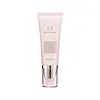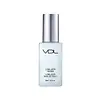What's inside
What's inside
 Key Ingredients
Key Ingredients

 Benefits
Benefits

 Concerns
Concerns

 Ingredients Side-by-side
Ingredients Side-by-side

Water
Skin ConditioningCyclopentasiloxane
EmollientCyclohexasiloxane
EmollientButylene Glycol
HumectantGlycerin
HumectantMica
Cosmetic ColorantPEG-10 Dimethicone
Skin ConditioningCI 77891
Cosmetic ColorantNiacinamide
SmoothingPentylene Glycol
Skin ConditioningDisteardimonium Hectorite
StabilisingDiamond Powder
AbrasiveMoringa Oleifera Seed Oil
EmollientRuby Powder
Skin ConditioningAmethyst Powder
AbrasivePearl Powder
Tourmaline
Chrysanthemum Morifolium Flower Extract
Skin ConditioningJasminum Officinale Extract
MaskingPlatinum Powder
AbrasiveDicaprylyl Carbonate
EmollientMagnesium Sulfate
Methyl Methacrylate Crosspolymer
Triethoxycaprylylsilane
Ethylhexylglycerin
Skin ConditioningAcrylates/Dimethicone Copolymer
Skin ConditioningAdenosine
Skin ConditioningMannan
Squalane
EmollientPolymethylsilsesquioxane
Caprylic/Capric Triglyceride
MaskingTocopherol
AntioxidantTalc
AbrasiveDisodium EDTA
Phenoxyethanol
PreservativeParfum
MaskingWater, Cyclopentasiloxane, Cyclohexasiloxane, Butylene Glycol, Glycerin, Mica, PEG-10 Dimethicone, CI 77891, Niacinamide, Pentylene Glycol, Disteardimonium Hectorite, Diamond Powder, Moringa Oleifera Seed Oil, Ruby Powder, Amethyst Powder, Pearl Powder, Tourmaline, Chrysanthemum Morifolium Flower Extract, Jasminum Officinale Extract, Platinum Powder, Dicaprylyl Carbonate, Magnesium Sulfate, Methyl Methacrylate Crosspolymer, Triethoxycaprylylsilane, Ethylhexylglycerin, Acrylates/Dimethicone Copolymer, Adenosine, Mannan, Squalane, Polymethylsilsesquioxane, Caprylic/Capric Triglyceride, Tocopherol, Talc, Disodium EDTA, Phenoxyethanol, Parfum
Water
Skin ConditioningCyclopentasiloxane
EmollientCyclohexasiloxane
EmollientNeopentyl Glycol Diethylhexanoate
EmollientButylene Glycol
HumectantPEG-10 Dimethicone
Skin ConditioningSynthetic Fluorphlogopite
Glycerin
HumectantDipropylene Glycol
HumectantCI 77891
Cosmetic ColorantMagnesium Sulfate
Dimethicone Crosspolymer
Emulsion StabilisingSorbitan Sesquiisostearate
EmulsifyingPanthenol
Skin ConditioningDisteardimonium Hectorite
StabilisingPhenoxyethanol
Preservative1,2-Hexanediol
Skin ConditioningDistearyldimonium Chloride
Tocopheryl Acetate
AntioxidantStearic Acid
CleansingTin Oxide
AbrasiveAlpha-Isomethyl Ionone
PerfumingBenzyl Benzoate
AntimicrobialCitronellol
PerfumingLimonene
PerfumingHexyl Cinnamal
PerfumingLinalool
PerfumingHydroxyisohexyl 3-Cyclohexene Carboxaldehyde
MaskingButylphenyl Methylpropional
PerfumingParfum
MaskingWater, Cyclopentasiloxane, Cyclohexasiloxane, Neopentyl Glycol Diethylhexanoate, Butylene Glycol, PEG-10 Dimethicone, Synthetic Fluorphlogopite, Glycerin, Dipropylene Glycol, CI 77891, Magnesium Sulfate, Dimethicone Crosspolymer, Sorbitan Sesquiisostearate, Panthenol, Disteardimonium Hectorite, Phenoxyethanol, 1,2-Hexanediol, Distearyldimonium Chloride, Tocopheryl Acetate, Stearic Acid, Tin Oxide, Alpha-Isomethyl Ionone, Benzyl Benzoate, Citronellol, Limonene, Hexyl Cinnamal, Linalool, Hydroxyisohexyl 3-Cyclohexene Carboxaldehyde, Butylphenyl Methylpropional, Parfum
Ingredients Explained
These ingredients are found in both products.
Ingredients higher up in an ingredient list are typically present in a larger amount.
Butylene Glycol (or BG) is used within cosmetic products for a few different reasons:
Overall, Butylene Glycol is a safe and well-rounded ingredient that works well with other ingredients.
Though this ingredient works well with most skin types, some people with sensitive skin may experience a reaction such as allergic rashes, closed comedones, or itchiness.
Learn more about Butylene GlycolCi 77891 is a white pigment from Titanium dioxide. It is naturally found in minerals such as rutile and ilmenite.
It's main function is to add a white color to cosmetics. It can also be mixed with other colors to create different shades.
Ci 77891 is commonly found in sunscreens due to its ability to block UV rays.
Learn more about CI 77891Cyclohexasiloxane is a type of silicone more commonly known as D6. It is an emollient and solvent.
Cyclohexasiloxane is used to evenly distribute ingredients throughout the product. When applied to the skin, Cyclohexasiloxane evaporates and leaves behind a silky feel.
As an emollient, it can help the skin feel soft and hydrated. It is also used to reduce frizz in hair products.
Learn more about CyclohexasiloxaneCyclopentasiloxane, or D5, is a silicone used to improve texture of products and trap moisture.
D5 is considered lightweight and volatile. Volatile means it evaporates quickly after application. Once evaporated, D5 leaves a thin barrier that helps keep skin hydrated.
It is also an emollient. Emollients help soften the skin and prevent water loss. Silicones create a silky texture in products. D5 helps other ingredients become more spreadable.
Studies show D5 is safe to use in skincare products. We recommend speaking with a skincare professional if you have concerns.
Learn more about CyclopentasiloxaneDisteardimonium Hectorite comes from the clay mineral named hectorite. It is used to add thickness to a product.
It can also help stabilize a product by helping to disperse other ingredients.
Hectorite is a rare, white clay mineral.
Learn more about Disteardimonium HectoriteGlycerin is already naturally found in your skin. It helps moisturize and protect your skin.
A study from 2016 found glycerin to be more effective as a humectant than AHAs and hyaluronic acid.
As a humectant, it helps the skin stay hydrated by pulling moisture to your skin. The low molecular weight of glycerin allows it to pull moisture into the deeper layers of your skin.
Hydrated skin improves your skin barrier; Your skin barrier helps protect against irritants and bacteria.
Glycerin has also been found to have antimicrobial and antiviral properties. Due to these properties, glycerin is often used in wound and burn treatments.
In cosmetics, glycerin is usually derived from plants such as soybean or palm. However, it can also be sourced from animals, such as tallow or animal fat.
This ingredient is organic, colorless, odorless, and non-toxic.
Glycerin is the name for this ingredient in American English. British English uses Glycerol/Glycerine.
Learn more about GlycerinMagnesium Sulfate is a salt. More specifically, it is an epsom salt, or the bath salt used to help relieve muscle aches.
Despite having ‘sulfate’ in the name, it isn’t a surfactant or cleansing agent like sodium lauryl sulfate. Unlike those sulfates, magnesium sulfate doesn’t have the same cleansing or foaming properties (it's simply a type of salt).
In cosmetics, Magnesium Sulfate is used to thicken a product or help dilute other solids. It is a non-reactive and non-irritating ingredient.
One study shows magnesium deficiency may lead to inflammation of the skin. Applying magnesium topically may help reduce inflammation.
You can find this ingredient in sea water or mineral deposits.
Learn more about Magnesium SulfateParfum is a catch-all term for an ingredient or more that is used to give a scent to products.
Also called "fragrance", this ingredient can be a blend of hundreds of chemicals or plant oils. This means every product with "fragrance" or "parfum" in the ingredients list is a different mixture.
For instance, Habanolide is a proprietary trade name for a specific aroma chemical. When used as a fragrance ingredient in cosmetics, most aroma chemicals fall under the broad labeling category of “FRAGRANCE” or “PARFUM” according to EU and US regulations.
The term 'parfum' or 'fragrance' is not regulated in many countries. In many cases, it is up to the brand to define this term.
For instance, many brands choose to label themselves as "fragrance-free" because they are not using synthetic fragrances. However, their products may still contain ingredients such as essential oils that are considered a fragrance by INCI standards.
One example is Calendula flower extract. Calendula is an essential oil that still imparts a scent or 'fragrance'.
Depending on the blend, the ingredients in the mixture can cause allergies and sensitivities on the skin. Some ingredients that are known EU allergens include linalool and citronellol.
Parfum can also be used to mask or cover an unpleasant scent.
The bottom line is: not all fragrances/parfum/ingredients are created equally. If you are worried about fragrances, we recommend taking a closer look at an ingredient. And of course, we always recommend speaking with a professional.
Learn more about ParfumPeg-10 Dimethicone is silicone with conditioner and emulsifier properties. It mostly acts as an emollient in skincare and and humectant in haircare.
According to the manufacturer, acidic formulations decrease the stability of this ingredient. It works best in neutral or near neutral formulations.
Phenoxyethanol is a preservative that has germicide, antimicrobial, and aromatic properties. Studies show that phenoxyethanol can prevent microbial growth. By itself, it has a scent that is similar to that of a rose.
It's often used in formulations along with Caprylyl Glycol to preserve the shelf life of products.
Water. It's the most common cosmetic ingredient of all. You'll usually see it at the top of ingredient lists, meaning that it makes up the largest part of the product.
So why is it so popular? Water most often acts as a solvent - this means that it helps dissolve other ingredients into the formulation.
You'll also recognize water as that liquid we all need to stay alive. If you see this, drink a glass of water. Stay hydrated!
Learn more about Water